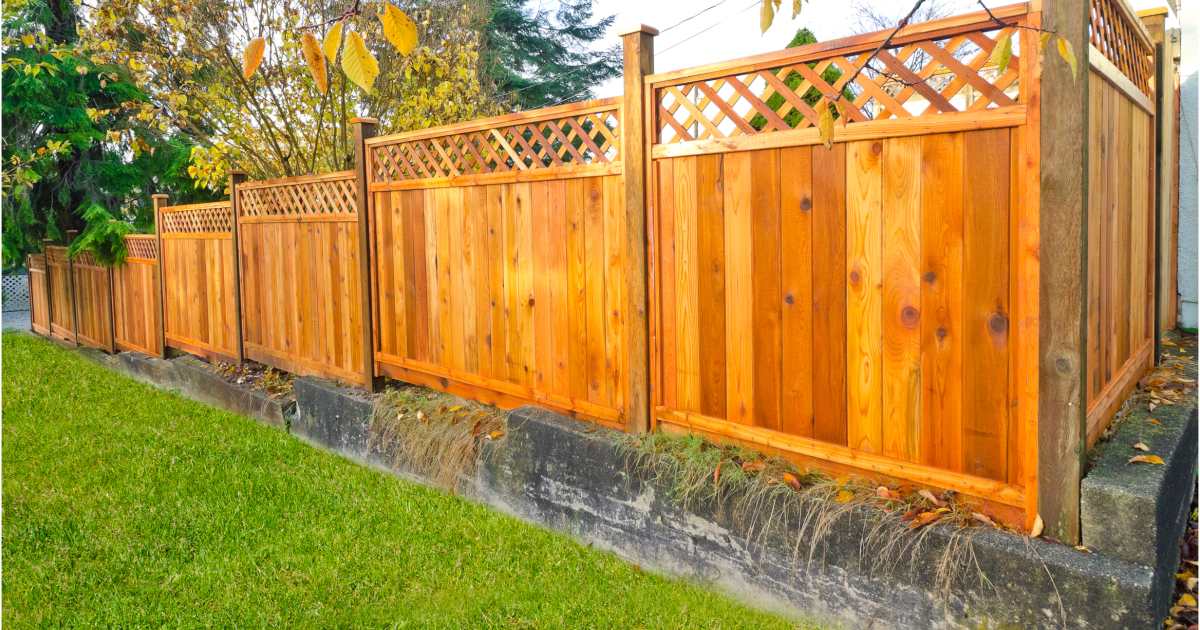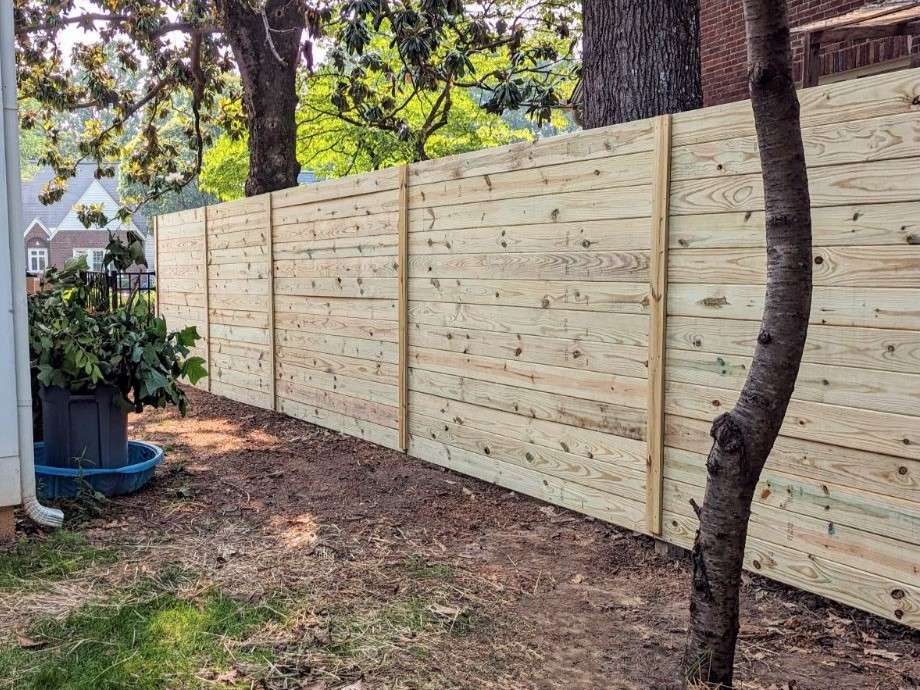Featured
Keeping your fence is necessary to ensure its functionality, look, and longevity. Different materials have distinct upkeep demands, influenced by elements such as climate, direct exposure to aspects, and planned use. Whether your fencing is made of timber, vinyl, metal, or various other products, comprehending its treatment demands will certainly aid keep it in ideal condition. Here's a review of just how to maintain various kinds of fencing materials successfully.
![]()
Cleansing: Make use of a pressure washing machine or soapy water with a soft brush to eliminate algae, mold, and dust. This must be done every year or biannually. Securing and staining: Use a sealer or stain every 2-- 3 years to avoid moisture damage and UV fading. Choose a top notch item suitable for outside use. Fixings: Replace distorted, rotted, or split boards as quickly as possible to stay clear of additional damage. Bug Monitoring: Treat with a timber chemical to protect against termites and other parasites. 2. Plastic Fencings. Plastic fences are preferred for their low-maintenance nature but still need some maintenance.
Cleansing: Laundry the fence with a mixture of water and moderate cleaning agent making use of a soft sponge or towel. Stay clear of unpleasant cleansers that may scrape the surface area. Assessments: Look for cracks or spaces periodically, specifically after tornados. Plastic can end up being fragile in exceptionally cool climate. Preventing Staining: Eliminate stains quickly. For hard spots, make use of a vinegar remedy or a vinyl-safe cleaning representative. 3. Chain-Link Fences. Chain-link fencings are resilient and practical, typically made use of for safety and limit noting.
Corrosion Elimination: Examine for rust routinely, specifically in coastal or damp areas. Remove corrosion with a cable brush and use a rust-proof finish. Cleansing: Wash with water to eliminate dirt and particles. Utilize a scrub brush for locations with hefty build-up. Tightening and Repair Works: Make certain the messages and links continue to be tight. Replace damaged areas or equipment as required. 4. Wrought Iron Fences. Wrought iron supplies a classy appearance but needs regular attention to stop corrosion and keep its surface.
Corrosion Prevention: Sand off any type of corrosion places and use a rust-resistant primer and paint. This ought to be done annually or as required. Cleansing: Make use of a light soap remedy and a soft fabric or sponge to get rid of dust. Prevent extreme chemicals that might harm the steel. Painting: Reapply paint every couple of years to shield the iron and boost its look. 5. Light weight aluminum Fences. Aluminum fencings are lightweight, corrosion-resistant, and need very little treatment.
![]()
Cleansing: Usage soapy water and a fabric to clean up the fencing, washing completely to stay clear of touches. Evaluations: Examine for loose screws or panels regularly. If essential, protect or replace parts. Touch-Ups: Use paint made for light weight aluminum to cover any kind of scrapes or chips, safeguarding the steel below. 6. Compound Fences. Composite fence is made from recycled materials, integrating the appearance of wood with higher longevity.
Cleaning: Rinse with water and use a moderate cleaning agent to eliminate dirt and stains. Prevent unpleasant devices that could harm the composite surface. Inspections: Look for indications of warping or breaking, especially in areas with extreme temperature level adjustments. Build Avoidance: Tidy mold or mildew without delay with a mixture of water and white vinegar. 7. Bamboo Fences. Bamboo fence is green yet a lot more delicate than various other products.
Cleaning: Use a soft brush with soapy water to clean dirt and debris. Avoid utilizing extreme water pressure to avoid splitting. Sealing: Use a waterproof sealant every 2-- 3 years to protect versus weather condition damages. Repair services: Change broken or broken bamboo poles as required to maintain the structure and appearance. General Upkeep Tips. Trim Plant Life: Maintain shrubs and vines away from the fencing to avoid dampness accumulation and damages. Seasonal Treatment: In winter, clear snow build-up from fencings to avoid tension on the structure. In summer season, check for sunlight damage or fading. Normal Assessments: Stroll along the fencing line occasionally to look for loosened hardware, leaning areas, or other indicators of wear. Conclusion. Despite the sort of fencing material, normal upkeep is the crucial to protecting its function and visual appeals. Wood fences require one of the most upkeep, while vinyl and light weight aluminum call for much less initiative yet still advantage from periodic cleaning and inspections. By addressing minor issues early and carrying out routine care, you'll appreciate a fencing that stays sturdy and attractive for several years ahead.

- Wooden Fencings. Wood fences are traditional however call for routine like shield versus weather and insects.
Cleansing: Make use of a pressure washing machine or soapy water with a soft brush to eliminate algae, mold, and dust. This must be done every year or biannually. Securing and staining: Use a sealer or stain every 2-- 3 years to avoid moisture damage and UV fading. Choose a top notch item suitable for outside use. Fixings: Replace distorted, rotted, or split boards as quickly as possible to stay clear of additional damage. Bug Monitoring: Treat with a timber chemical to protect against termites and other parasites. 2. Plastic Fencings. Plastic fences are preferred for their low-maintenance nature but still need some maintenance.
Cleansing: Laundry the fence with a mixture of water and moderate cleaning agent making use of a soft sponge or towel. Stay clear of unpleasant cleansers that may scrape the surface area. Assessments: Look for cracks or spaces periodically, specifically after tornados. Plastic can end up being fragile in exceptionally cool climate. Preventing Staining: Eliminate stains quickly. For hard spots, make use of a vinegar remedy or a vinyl-safe cleaning representative. 3. Chain-Link Fences. Chain-link fencings are resilient and practical, typically made use of for safety and limit noting.
Corrosion Elimination: Examine for rust routinely, specifically in coastal or damp areas. Remove corrosion with a cable brush and use a rust-proof finish. Cleansing: Wash with water to eliminate dirt and particles. Utilize a scrub brush for locations with hefty build-up. Tightening and Repair Works: Make certain the messages and links continue to be tight. Replace damaged areas or equipment as required. 4. Wrought Iron Fences. Wrought iron supplies a classy appearance but needs regular attention to stop corrosion and keep its surface.
Corrosion Prevention: Sand off any type of corrosion places and use a rust-resistant primer and paint. This ought to be done annually or as required. Cleansing: Make use of a light soap remedy and a soft fabric or sponge to get rid of dust. Prevent extreme chemicals that might harm the steel. Painting: Reapply paint every couple of years to shield the iron and boost its look. 5. Light weight aluminum Fences. Aluminum fencings are lightweight, corrosion-resistant, and need very little treatment.

Cleansing: Usage soapy water and a fabric to clean up the fencing, washing completely to stay clear of touches. Evaluations: Examine for loose screws or panels regularly. If essential, protect or replace parts. Touch-Ups: Use paint made for light weight aluminum to cover any kind of scrapes or chips, safeguarding the steel below. 6. Compound Fences. Composite fence is made from recycled materials, integrating the appearance of wood with higher longevity.
Cleaning: Rinse with water and use a moderate cleaning agent to eliminate dirt and stains. Prevent unpleasant devices that could harm the composite surface. Inspections: Look for indications of warping or breaking, especially in areas with extreme temperature level adjustments. Build Avoidance: Tidy mold or mildew without delay with a mixture of water and white vinegar. 7. Bamboo Fences. Bamboo fence is green yet a lot more delicate than various other products.
Cleaning: Use a soft brush with soapy water to clean dirt and debris. Avoid utilizing extreme water pressure to avoid splitting. Sealing: Use a waterproof sealant every 2-- 3 years to protect versus weather condition damages. Repair services: Change broken or broken bamboo poles as required to maintain the structure and appearance. General Upkeep Tips. Trim Plant Life: Maintain shrubs and vines away from the fencing to avoid dampness accumulation and damages. Seasonal Treatment: In winter, clear snow build-up from fencings to avoid tension on the structure. In summer season, check for sunlight damage or fading. Normal Assessments: Stroll along the fencing line occasionally to look for loosened hardware, leaning areas, or other indicators of wear. Conclusion. Despite the sort of fencing material, normal upkeep is the crucial to protecting its function and visual appeals. Wood fences require one of the most upkeep, while vinyl and light weight aluminum call for much less initiative yet still advantage from periodic cleaning and inspections. By addressing minor issues early and carrying out routine care, you'll appreciate a fencing that stays sturdy and attractive for several years ahead.
Latest Posts
Find Out How Your Partner at WyHy Saves You Money on Borrowing and Banking
Published May 26, 25
1 min read
Trustworthy Industrial Roof Services by Weathercraft
Published May 22, 25
1 min read
Boost Your Residential Or Commercial Property with Expenses Door Systems
Published May 21, 25
1 min read